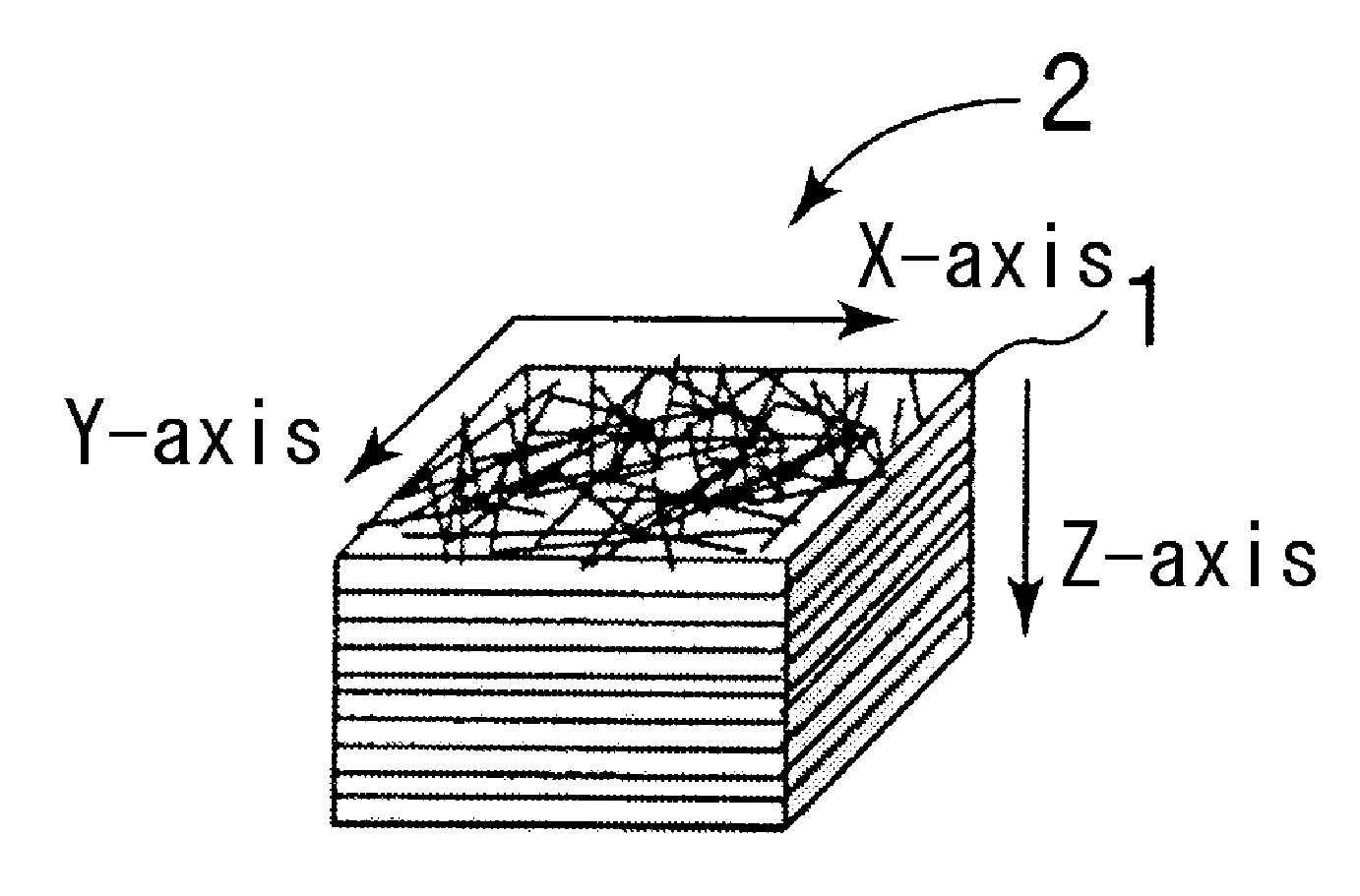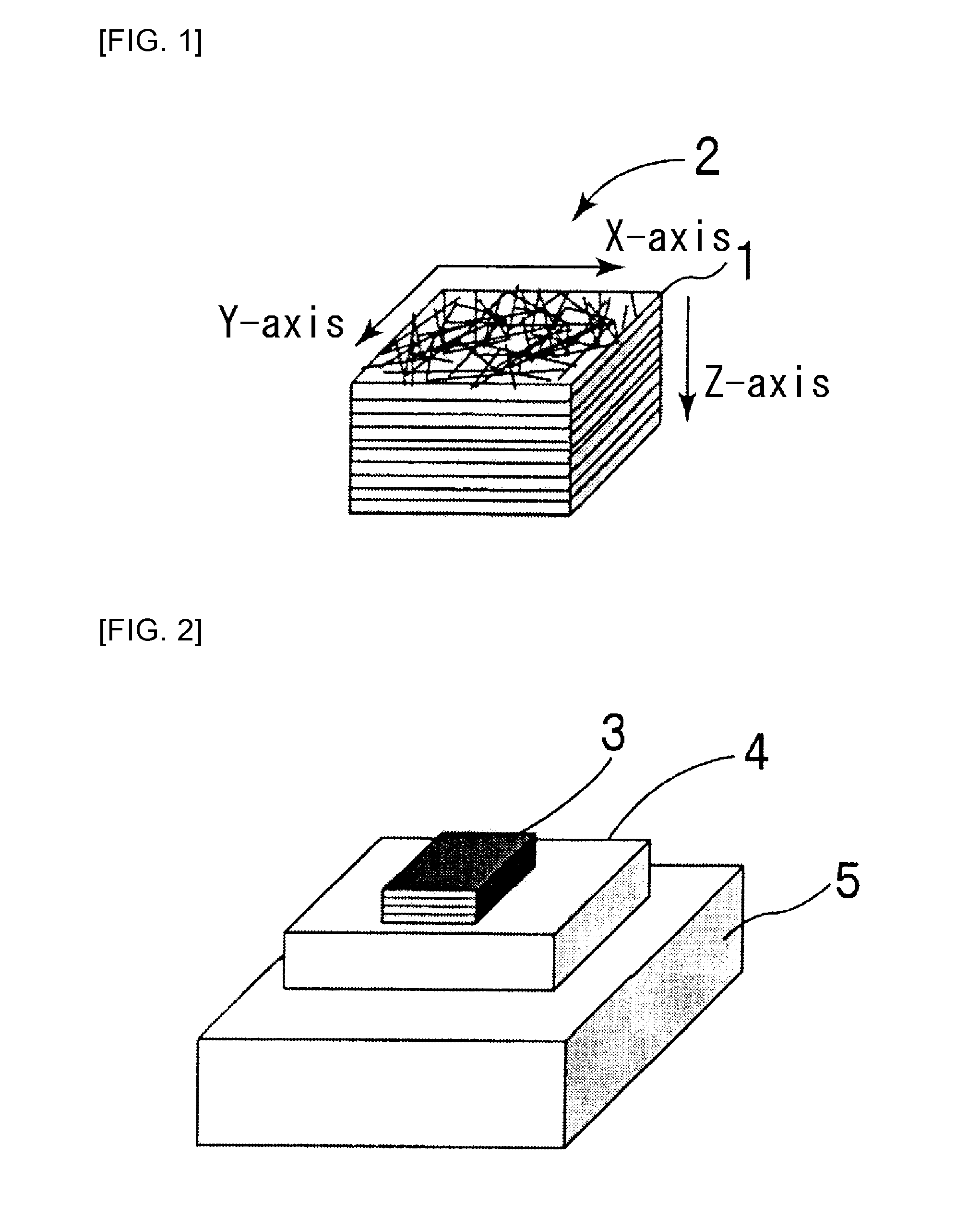Carbon fiber carbon composite molded body, carbon fiber-reinforced carbon composite material and manufacturing method thereof
a carbon fiber and composite material technology, applied in the direction of solid-state devices, metallic material coating processes, electrical devices, etc., can solve the problems of insufficient thermal conductivity, diamond components have the problem of high cost, and materials are subject to some restrictions, etc., to achieve excellent thermal conductivity excellent thermal conductivity
- Summary
- Abstract
- Description
- Claims
- Application Information
AI Technical Summary
Benefits of technology
Problems solved by technology
Method used
Image
Examples
example 1
[0059]Pitch-based carbon fibers (a yarn of 12000 (12K) filaments, average diameter: 9 μm, density: 1.93 Mg / m3) were cut into lengths of about 30 to 100 mm, and a sizing agent was removed therefrom using acetone or the like. The carbon fibers were dispersed in random directions, and then bonded together with 30 parts by mass of phenol resin relative to 100 parts by mass of carbon fibers, thereby preparing sheet-like prepregs (thickness: approximately 0.5 mm) in which the carbon fibers were dispersed randomly in the plane containing the X and Y axes. The prepregs were preliminarily dried in an oven at approximately 100° C. Approximately 100 prepregs after being dried were laminated and pressed into a certain form using a hot press under the conditions of a pressure of 0.3 MPa and a temperature of 150° C. Next, the form was subjected to heat treatment at approximately 2000° C., thereby obtaining a carbon fiber laminate having a size of 50 mm×50 mm×50 mm. The density of the carbon fiber...
example 2
[0072]A carbon fiber laminate was filled with pyrolytic carbon in the same manner as in Example 1, then repeatedly subjected to immersion into an easily graphitizable pitch of low quinoline insoluble content and heat treatment, and thereafter subjected to heat treatment for graphitization.
[0073]The density of the carbon fiber laminate was 0.25 Mg / m3, the density thereof after being filled with pyrolytic carbon was 1.75 Mg / m3, and the density thereof after being subjected to immersion into pitch and heat treatment was 1.82 Mg / m3. The crystal thickness d between adjacent (112) planes of graphite crystal after being subjected to graphitization treatment was 8 nm.
[0074]Determinations were made in the same manners as in Example 1, and the determination results are shown in TABLE 1.
example 3
[0075]Pyrolytic carbon was contained in a carbon fiber laminate in the same manner as in Example 1, and the carbon fiber laminate was then repeatedly subjected to immersion into a pitch and heat treatment, and then subjected to heat treatment for graphitization, thereby obtaining a carbon fiber-reinforced carbon composite material.
[0076]The density of the carbon fiber laminate was 0.20 Mg / m3, the density thereof after containing pyrolytic carbon was 1.75 Mg / m3, the density thereof after being impregnated with pitch was 1.95 Mg / m3, and the crystal thickness d between adjacent (112) planes of graphite crystal was 8 nm.
[0077]Determinations were made in the same manners as in Example 1, and the determination results are shown in TABLE 1.
PUM
| Property | Measurement | Unit |
|---|---|---|
| Thickness | aaaaa | aaaaa |
| Nanoscale particle size | aaaaa | aaaaa |
| Volume | aaaaa | aaaaa |
Abstract
Description
Claims
Application Information
 Login to View More
Login to View More - R&D
- Intellectual Property
- Life Sciences
- Materials
- Tech Scout
- Unparalleled Data Quality
- Higher Quality Content
- 60% Fewer Hallucinations
Browse by: Latest US Patents, China's latest patents, Technical Efficacy Thesaurus, Application Domain, Technology Topic, Popular Technical Reports.
© 2025 PatSnap. All rights reserved.Legal|Privacy policy|Modern Slavery Act Transparency Statement|Sitemap|About US| Contact US: help@patsnap.com



